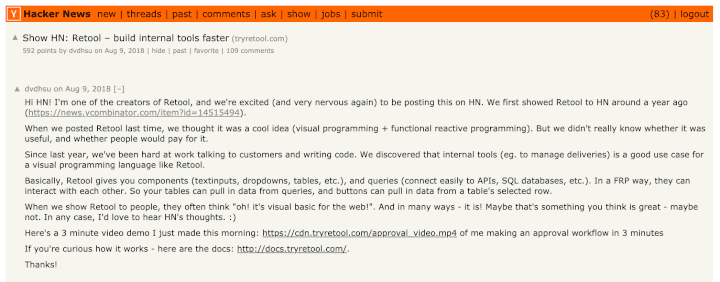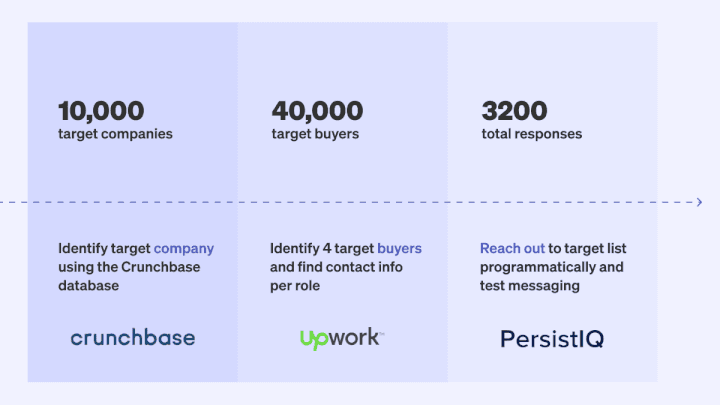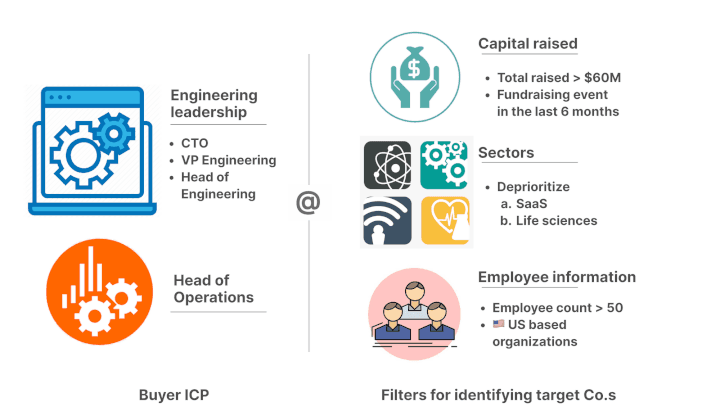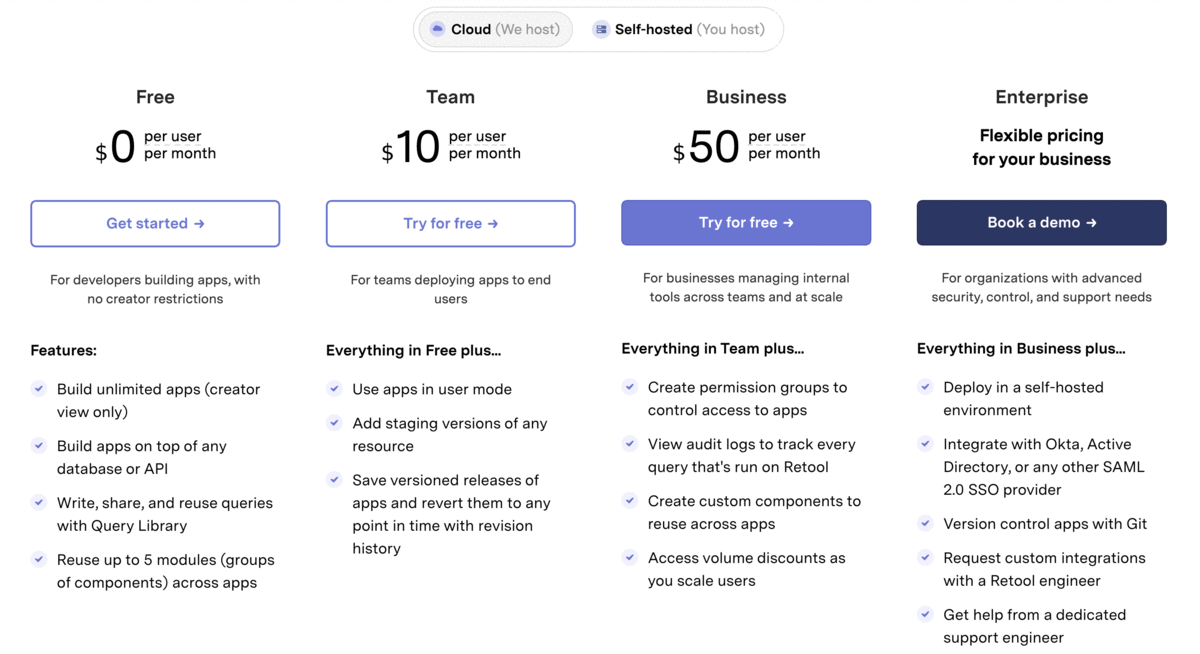Retool: Saving developers from internal tools since 2017 😇
Retool: Saving developers from internal tools since 2017 😇
Retool: Saving developers from internal tools since 2017 😇
In a world desperately in the need of developers, why would you waste their time on internal tools?
In a world desperately in the need of developers, why would you waste their time on internal tools?
In a world desperately in the need of developers, why would you waste their time on internal tools?



“Who run the world?” I don’t know Beyoncé, but there is an argument to be made for the Global enterprise applications industry.
Estimated to reach a whopping $250B dollars in market size by 2022, internal tools are the lifeblood of any enterprise. The number of these apps deployed by large firms across all industries worldwide had grown 68% over four years until last year, reaching an average of 129 apps per company.
The problem? Developers who earn six figures today spend around 30% of their time building internal tools. The number goes up to 40% once the company scales to 5000+ employees. Tooling quickly becomes a time-sink for engineers.
Selecting software for building internal tools is a critical problem for any company to solve. But it is a problem that a philosophy and computer science graduate from Oxford may have found the solution to.
Arise, Sir David Hsu and Retool
If you met Retool CEO David Hsu at Olives, a popular French delicatessen on High Street in Oxford back in 2017, you would have known him as the creator of “Cashew”, a “Venmo for the UK”, and there’s a good chance you were paying for your parma ham and coffee using the app that he created.
Although the unit economics of the Fintech app was difficult to solve and left them running out of runway quickly, David and the team understood the problem of internal tools not scaling well because they faced it themselves. They had spent a lot of time building internal tools for KYC, fraud prevention, etc., and were quick to recognize that there was a pattern emerging:
“[most internal tools] are just a bunch of tables, buttons, drop downs and forms that you have to build from scratch. What if there was a drag and drop way of building this faster?”
Today, Retool helps companies like Mercedes-Benz, Doordash, ABInBev, Fox, NBC, and many others build internal tools, fast. With >$10 million in revenue, Retool is valued at $925 million and is backed by Sequoia, and founders of Github, Gusto, PagerDuty, Plaid, Segment, Stripe, and Y Combinator.
“Excel-like, with higher-order primitives"?! 🤷🏻♂️
“I had infiltrated a LinkedIn user group for FileMaker users. I now had 300-400 people that I could send emails to. So I set up an email saying that Retool is like FileMaker but for the cloud and sent that out.” - David Hsu
The 3 people who replied all told him that this was a terrible idea, they would never use it, and that David and the team should probably go work on something else. Retool’s first major pivot in finding product-market fit was the market itself.
Their market was not FileMaker or MS Access users. It was software developers building front-end tools! 👩🏻��
The second pivot was the messaging. Here’s the post on Hackernews announcing Retool’s launch to the world:

And here’s the same announcement, translated from the original Greek, posted a year later on Hackernews:

Product-led sales on Day 0? 🙅🏻♂️ Nope!

“The only way that you could learn about Retool [in the early days] was for me to email you and tell you about it.” - David Hsu
For the first year and a half, Retool's growth was founder-led. Here's how they raced to over a million dollars in revenue in one year:

Step1: The team scoured Crunchbase pro to identify 10,000 targets that fit the description of the companies they wanted to introduce Retool to early on.
“Typically, if a company has raised money in the past 6 months, it means that they are looking to expand, grow, and operationalize what’s already been working,” says David.
Step2: The founding team used Upwork to convert the 10,000 targets into individuals at these companies, zeroing in on specific personas:
Head of Engineering Blog
VP of Engineering Blog
CTO
Head of Ops
The sales playbook spreadsheet now had 40,000 names in it. Over the coming weeks, all of them were about to hear about Retool for the first time.

Step3: David turned to PersistIQ, a sales automation tool in order to reach out to the 40,000. After A/B testing a bunch of copies, the team finally found the subject line and messaging that worked and hit their inboxes.
At a conversion rate of 8%, they turned many of these responses into early adopters and even signed an enterprise customer pilot worth $1.5M! They hadn't made a single hire outside the founding team yet 🤯
The shift to inbound and product-led growth 🤩
“From the moment we launched Retool on Hacker News, our business basically immediately shifted to inbound,” says David. “We had 5, 10, 15, 20 companies signing up for Retool every day."
The team hired a GTM team to handle the large volume of inbound sales rushing in to sign up for Retool. Devon Groff, one of the first sales engineers to be hired, along with David set up real-time alerts to delight early customers by intervening at three key stages:
Big fish swimming - real-time notification alerting the entire company on Slack whenever a large account was using Retool.
Big fish errors - Slack alerts when users experienced failures or issues.
Shared channels - Proactively reach out to developers using shared Slack channels to debug errors together.
The Sales team has grown 5x in the last year and is the largest team in the organization after Engineering Blog today, making inroads upmarket to both Fortune 500 giants as well as start-ups.
Key accounts to target are identified by Business Development Reps who are the tip of the spear of growth at Retool. They find and message personas that are likely to get significant value from Retool.
Account Executives and Enterprise Account Executives own deals from start to finish and help alleviate prospects' pain points by showing them the value and impact of Retool. They build, qualify and develop leads.
Customer Success Managers drive technical and business relations with customers, helping them exceed their goals in Retool. This includes everything from onboarding and launching new use-cases to helping them overcome technical challenges.
If you're an enterprise considering Retool for your internal apps, Sales Engineers will dive deep with you to understand your technical environment and goals and even build apps with you.
The team continues to innovate and evolve Sales with "Retools for Retool": built-for-purpose tools like a mock data generator for sales demos and an SDR dashboard built on top of Salesforce.
The company recently announced "Retool for startups" which offers early-stage start-ups up to a year of free access to advanced features! As a early-stage startup ourselves we couldn't be more excited 😅🙏🏻

Build-in hours, not days
“Whenever engineers would talk to each other about building internal tools, Retool would come up and new teams would try it.” - Rohan Chopra, Sr. Director of Engineering Blog, Doordash
Retool is primarily built for engineers and other technical folks, although it is also accessible to a broader audience. Using the low-code platform with its drag-and-drop interface, developers are able to build front-end components like forms, buttons, tables, etc. and connect to data sources in hours, rather than days. A smattering of custom code later, they are able to make these apps dance to their tune.
Retool grew 3x in revenue in the last year, and below are some of the ways in which they did it.
"Retool university" is a near-exhaustive resource dump aimed at making the onboarding process as easy as pie, especially for non-technical users. Together with a community that they've built to offer support, feature requests, etc., users are empowered to jump minor hurdles on their own.
A barrage of templates on offer can get you started on Retool quickly, with integrations possible with almost every type of database and API. Fast lead times and wide use cases ensure virality loops horizontally and vertically within organizations.
There is a range of paid plans offered for cloud and self-hosted apps, with the more advanced features like user-mode views, testing apps against staging databases, version control, and permission groups only available in the higher-tier plans.

⏭ What's next?
"And so, for us that, you know, is the second order effect, By making building software easier, lowering the bar for building software, now a lot more software is built," David on the Indiehackers podcast
Retool's revenue and business goals for the next year are aggressive, and they continue to scale their sales, marketing, and Engineering Blog teams rapidly to meet those goals.
Most businesses today drive efficiencies in their processes using the software. Retool brings efficiencies to these efficiencies. The Engineering Blog teams are left with more time on their hands to focus elsewhere, and the others are left with better tools to work with overall.
Gartner estimates that about half of all code written today is for internal tools. Retool may be about to change that 🚀
“Who run the world?” I don’t know Beyoncé, but there is an argument to be made for the Global enterprise applications industry.
Estimated to reach a whopping $250B dollars in market size by 2022, internal tools are the lifeblood of any enterprise. The number of these apps deployed by large firms across all industries worldwide had grown 68% over four years until last year, reaching an average of 129 apps per company.
The problem? Developers who earn six figures today spend around 30% of their time building internal tools. The number goes up to 40% once the company scales to 5000+ employees. Tooling quickly becomes a time-sink for engineers.
Selecting software for building internal tools is a critical problem for any company to solve. But it is a problem that a philosophy and computer science graduate from Oxford may have found the solution to.
Arise, Sir David Hsu and Retool
If you met Retool CEO David Hsu at Olives, a popular French delicatessen on High Street in Oxford back in 2017, you would have known him as the creator of “Cashew”, a “Venmo for the UK”, and there’s a good chance you were paying for your parma ham and coffee using the app that he created.
Although the unit economics of the Fintech app was difficult to solve and left them running out of runway quickly, David and the team understood the problem of internal tools not scaling well because they faced it themselves. They had spent a lot of time building internal tools for KYC, fraud prevention, etc., and were quick to recognize that there was a pattern emerging:
“[most internal tools] are just a bunch of tables, buttons, drop downs and forms that you have to build from scratch. What if there was a drag and drop way of building this faster?”
Today, Retool helps companies like Mercedes-Benz, Doordash, ABInBev, Fox, NBC, and many others build internal tools, fast. With >$10 million in revenue, Retool is valued at $925 million and is backed by Sequoia, and founders of Github, Gusto, PagerDuty, Plaid, Segment, Stripe, and Y Combinator.
“Excel-like, with higher-order primitives"?! 🤷🏻♂️
“I had infiltrated a LinkedIn user group for FileMaker users. I now had 300-400 people that I could send emails to. So I set up an email saying that Retool is like FileMaker but for the cloud and sent that out.” - David Hsu
The 3 people who replied all told him that this was a terrible idea, they would never use it, and that David and the team should probably go work on something else. Retool’s first major pivot in finding product-market fit was the market itself.
Their market was not FileMaker or MS Access users. It was software developers building front-end tools! 👩🏻��
The second pivot was the messaging. Here’s the post on Hackernews announcing Retool’s launch to the world:

And here’s the same announcement, translated from the original Greek, posted a year later on Hackernews:

Product-led sales on Day 0? 🙅🏻♂️ Nope!

“The only way that you could learn about Retool [in the early days] was for me to email you and tell you about it.” - David Hsu
For the first year and a half, Retool's growth was founder-led. Here's how they raced to over a million dollars in revenue in one year:

Step1: The team scoured Crunchbase pro to identify 10,000 targets that fit the description of the companies they wanted to introduce Retool to early on.
“Typically, if a company has raised money in the past 6 months, it means that they are looking to expand, grow, and operationalize what’s already been working,” says David.
Step2: The founding team used Upwork to convert the 10,000 targets into individuals at these companies, zeroing in on specific personas:
Head of Engineering Blog
VP of Engineering Blog
CTO
Head of Ops
The sales playbook spreadsheet now had 40,000 names in it. Over the coming weeks, all of them were about to hear about Retool for the first time.

Step3: David turned to PersistIQ, a sales automation tool in order to reach out to the 40,000. After A/B testing a bunch of copies, the team finally found the subject line and messaging that worked and hit their inboxes.
At a conversion rate of 8%, they turned many of these responses into early adopters and even signed an enterprise customer pilot worth $1.5M! They hadn't made a single hire outside the founding team yet 🤯
The shift to inbound and product-led growth 🤩
“From the moment we launched Retool on Hacker News, our business basically immediately shifted to inbound,” says David. “We had 5, 10, 15, 20 companies signing up for Retool every day."
The team hired a GTM team to handle the large volume of inbound sales rushing in to sign up for Retool. Devon Groff, one of the first sales engineers to be hired, along with David set up real-time alerts to delight early customers by intervening at three key stages:
Big fish swimming - real-time notification alerting the entire company on Slack whenever a large account was using Retool.
Big fish errors - Slack alerts when users experienced failures or issues.
Shared channels - Proactively reach out to developers using shared Slack channels to debug errors together.
The Sales team has grown 5x in the last year and is the largest team in the organization after Engineering Blog today, making inroads upmarket to both Fortune 500 giants as well as start-ups.
Key accounts to target are identified by Business Development Reps who are the tip of the spear of growth at Retool. They find and message personas that are likely to get significant value from Retool.
Account Executives and Enterprise Account Executives own deals from start to finish and help alleviate prospects' pain points by showing them the value and impact of Retool. They build, qualify and develop leads.
Customer Success Managers drive technical and business relations with customers, helping them exceed their goals in Retool. This includes everything from onboarding and launching new use-cases to helping them overcome technical challenges.
If you're an enterprise considering Retool for your internal apps, Sales Engineers will dive deep with you to understand your technical environment and goals and even build apps with you.
The team continues to innovate and evolve Sales with "Retools for Retool": built-for-purpose tools like a mock data generator for sales demos and an SDR dashboard built on top of Salesforce.
The company recently announced "Retool for startups" which offers early-stage start-ups up to a year of free access to advanced features! As a early-stage startup ourselves we couldn't be more excited 😅🙏🏻

Build-in hours, not days
“Whenever engineers would talk to each other about building internal tools, Retool would come up and new teams would try it.” - Rohan Chopra, Sr. Director of Engineering Blog, Doordash
Retool is primarily built for engineers and other technical folks, although it is also accessible to a broader audience. Using the low-code platform with its drag-and-drop interface, developers are able to build front-end components like forms, buttons, tables, etc. and connect to data sources in hours, rather than days. A smattering of custom code later, they are able to make these apps dance to their tune.
Retool grew 3x in revenue in the last year, and below are some of the ways in which they did it.
"Retool university" is a near-exhaustive resource dump aimed at making the onboarding process as easy as pie, especially for non-technical users. Together with a community that they've built to offer support, feature requests, etc., users are empowered to jump minor hurdles on their own.
A barrage of templates on offer can get you started on Retool quickly, with integrations possible with almost every type of database and API. Fast lead times and wide use cases ensure virality loops horizontally and vertically within organizations.
There is a range of paid plans offered for cloud and self-hosted apps, with the more advanced features like user-mode views, testing apps against staging databases, version control, and permission groups only available in the higher-tier plans.

⏭ What's next?
"And so, for us that, you know, is the second order effect, By making building software easier, lowering the bar for building software, now a lot more software is built," David on the Indiehackers podcast
Retool's revenue and business goals for the next year are aggressive, and they continue to scale their sales, marketing, and Engineering Blog teams rapidly to meet those goals.
Most businesses today drive efficiencies in their processes using the software. Retool brings efficiencies to these efficiencies. The Engineering Blog teams are left with more time on their hands to focus elsewhere, and the others are left with better tools to work with overall.
Gartner estimates that about half of all code written today is for internal tools. Retool may be about to change that 🚀
Related Articles




Behavioral Retargeting: A Game-Changer in the Cookieless Era
Unlock the power of behavioral retargeting for the cookieless future! Learn how it personalizes ads & boosts conversions. #behavioralretargeting




All of Toplyne's 40+ Badges in the G2 Spring Reports
Our customers awarded us 40+ badges in G2's Summer Report 2024.




Unlocking the Full Potential of Google PMax Campaigns: Mastering Audience Selection to Double Your ROAS
Copyright © Toplyne Labs PTE Ltd. 2024
Copyright © Toplyne Labs PTE Ltd. 2024
Copyright © Toplyne Labs PTE Ltd. 2024
Copyright © Toplyne Labs PTE Ltd. 2024